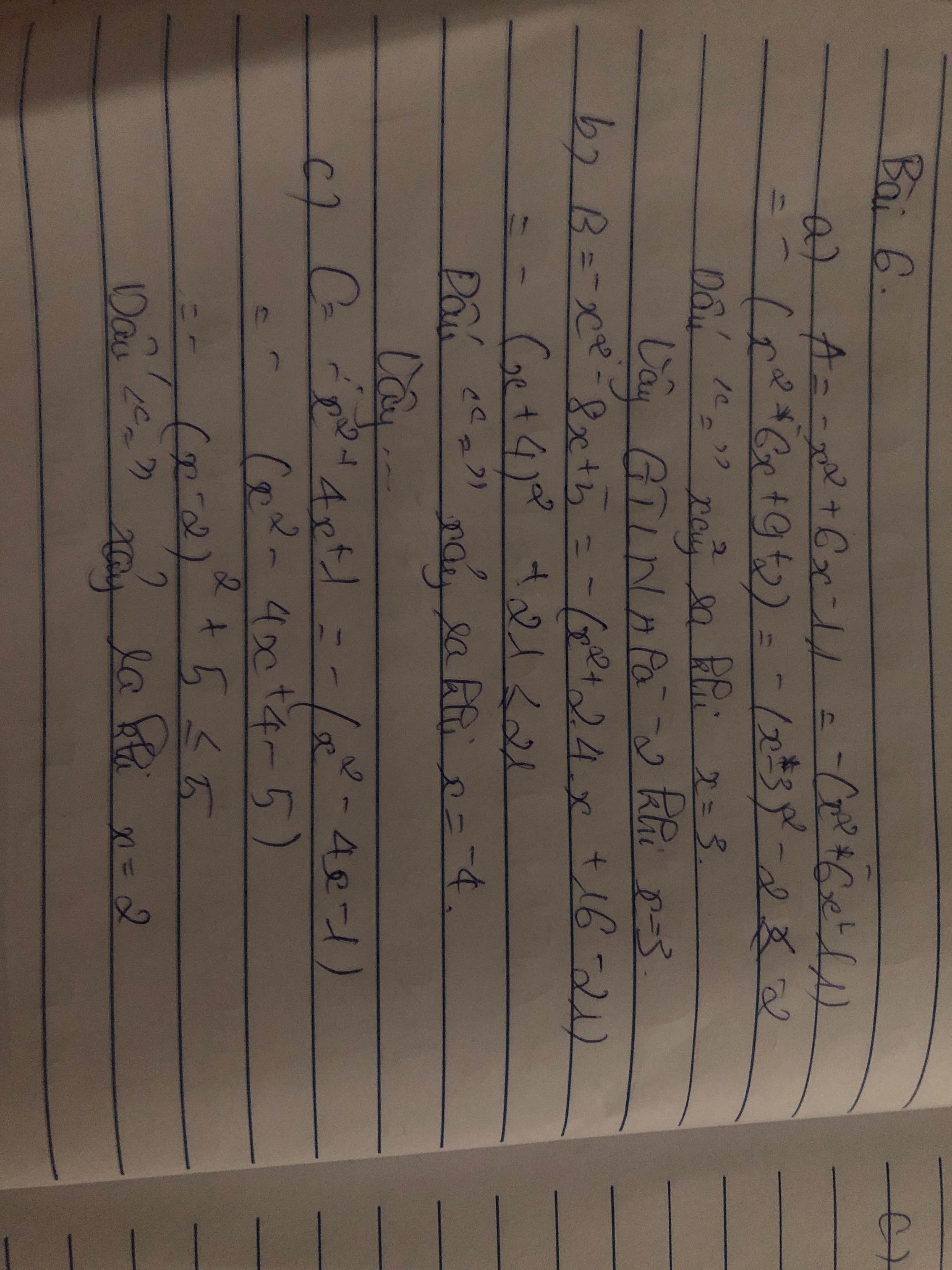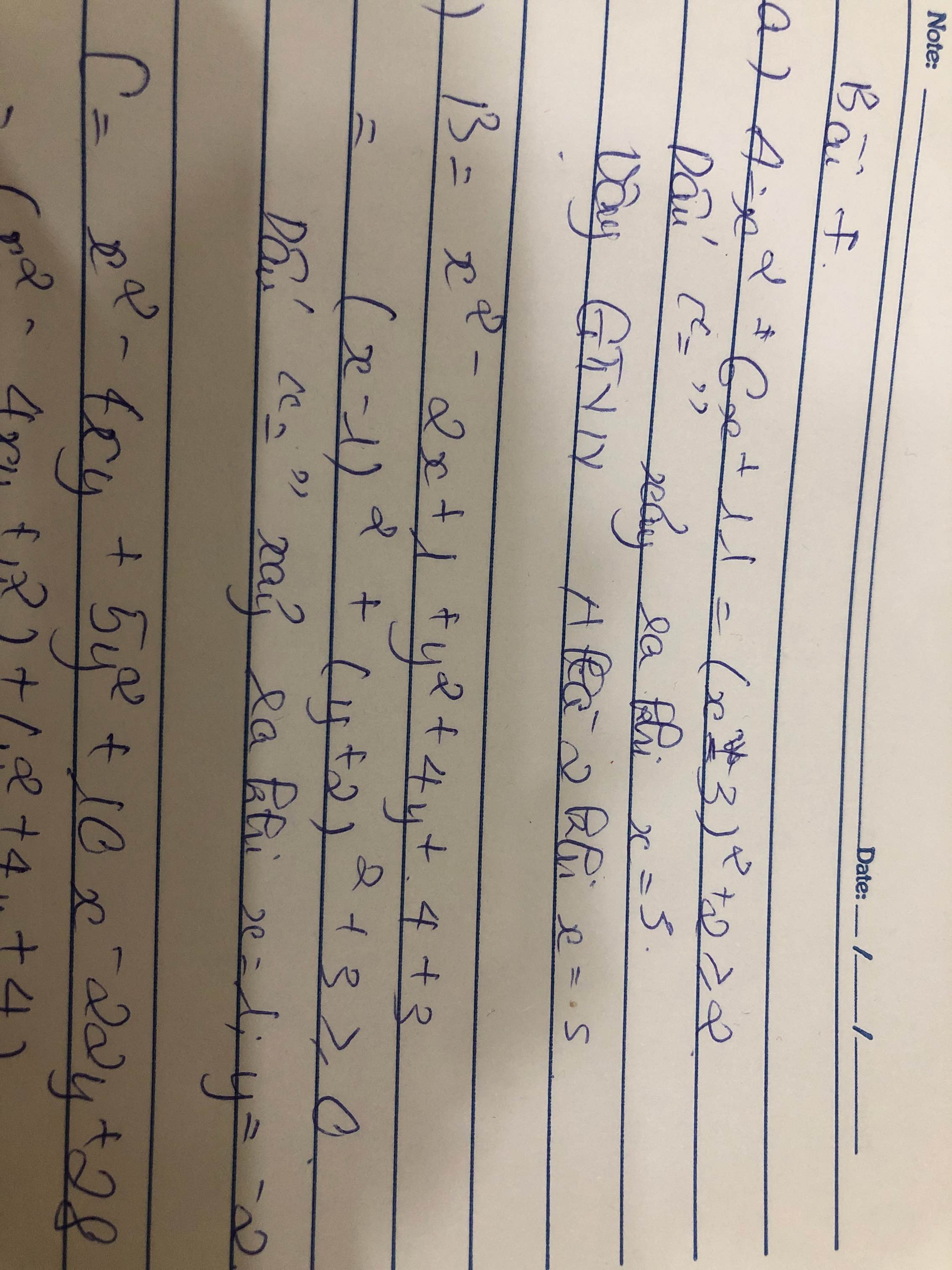Hãy nhập câu hỏi của bạn vào đây, nếu là tài khoản VIP, bạn sẽ được ưu tiên trả lời.

Ta có :
\(x^2-4x+5=\left(x^2-2.2x+2^2\right)+1=\left(x-2\right)^2+1\ge1>0\)
Vậy đa thức \(x^2-4x+5\) vô nghiệm với mọi giá trị của x
Chúc bạn học tốt ~

Bài 13:
1: \(A=-x^2+4x+3\)
\(=-\left(x^2-4x-3\right)=-\left(x^2-4x+4-7\right)\)
\(=-\left(x-2\right)^2+7\le7\)
Dấu '=' xảy ra khi x=2
2: \(B=-\left(x^2-6x+11\right)\)
\(=-\left(x-3\right)^2-2\le-2\)
Dấu '=' xảy ra khi x=3

Bài 12:
1) A = x2 - 6x + 11
= (x2 - 6x + 9) + 2
= (x - 3)2 + 2
Ta có: (x - 3)2 ≥ 0 ∀ x
Dấu ''='' xảy ra khi x - 3 = 0 ⇔ x = 3
Do đó: (x - 3)2 + 2 ≥ 2
Hay A ≥ 2
Dấu ''='' xảy ra khi x = 3
Vậy Min A = 2 tại x = 3
2) B = x2 - 20x + 101
= (x2 - 20x + 100) + 1
= (x - 10)2 + 1
Ta có: (x - 10)2 ≥ 0 ∀ x
Dấu ''='' xảy ra khi x - 10 = 0 ⇔ x = 10
Do đó: (x - 10)2 + 1 ≥ 1
Hay B ≥ 1
Dấu ''='' xảy ra khi x = 10
Vậy Min B = 1 tại x = 10

a) \(x^2\left(x^2+4\right)-x^2-4=x^2\left(x^2+4\right)-\left(x^2+4\right)=\left(x^2+4\right)\left(x^2-1\right)=\left(x^2+4\right)\left(x-1\right)\left(x+1\right)\)
b) \(\left(x^2+x\right)^2+4x^2+4x-12=\left(x^2+x\right)^2+4\left(x^2+x\right)+4-16=\left(x^2+x+2\right)^2-4^2=\left(x^2+x+2-4\right)\left(x^2+x+2+4\right)=\left(x^2+x-2\right)\left(x^2+x+6\right)=\left(x-1\right)\left(x+2\right)\left(x^2+x+6\right)\)
c) \(\left(x+2\right)\left(x+3\right)\left(x+4\right)\left(x+5\right)-24=\left(x^2+7x+10\right)\left(x^2+7x+12\right)-24=\left(x^2+7x+10\right)^2+2\left(x^2+7x+10\right)+1-25=\left(x^2+7x+11\right)^2-5^2=\left(x^2+7x+11-5\right)\left(x^2+7x+11+5\right)=\left(x^2+7x+6\right)\left(x^2+7x+16\right)=\left(x+1\right)\left(x+6\right)\left(x^2+7x+16\right)\)
a. \(x^2\left(x^2+4\right)-x^2-4\)
\(=x^2\left(x^2+4\right)-\left(x^2+4\right)\)
\(=\left(x^2-1\right)\left(x^2+4\right)\)
\(=\left(x-1\right)\left(x+1\right)\left(x^2+4\right)\)
b. \(\left(x^2+x\right)^2+4x^2+4x-12\)
\(=x^4+2x^3+5x^2+4x-12\)
\(=\left(x-1\right)\left(x+2\right)\left(x^2+x+6\right)\)
c. \(\left(x+2\right)\left(x+3\right)\left(x+4\right)\left(x+5\right)-24\)
\(=\left(x+2\right)\left(x+5\right)\left(x+3\right)\left(x+4\right)-24\)
\(=\left(x^2+7x+10\right)\left(x^2+7x+12\right)-24\) (*)
Đặt \(t=x^2+7x+10\), ta được
(*) \(=t\left(t+2\right)-24\)
\(=t^2+2t-24\)
\(=\left(t-4\right)\left(t+6\right)\)
hay \(\left(x^2+7x+6\right)\left(x^2+7x+18\right)\)

\(1,\\ a,A=4x^2\left(-3x^2+1\right)+6x^2\left(2x^2-1\right)+x^2\\ A=-12x^4+4x^2+12x^2-6x^2+x^2=-x^2=-\left(-1\right)^2=-1\\ b,B=x^2\left(-2y^3-2y^2+1\right)-2y^2\left(x^2y+x^2\right)\\ B=-2x^2y^3-2x^2y^2+x^2-2x^2y^3-2x^2y^2\\ B=-4x^2y^3-4x^2y^2+x^2\\ B=-4\left(0,5\right)^2\left(-\dfrac{1}{2}\right)^3-4\left(0,5\right)^2\left(-\dfrac{1}{2}\right)^2+\left(0,5\right)^2\\ B=\dfrac{1}{8}-\dfrac{1}{4}+\dfrac{1}{4}=\dfrac{1}{8}\)
\(2,\\ a,\Leftrightarrow10x-16-12x+15=12x-16+11\\ \Leftrightarrow-14x=-4\\ \Leftrightarrow x=\dfrac{2}{7}\\ b,\Leftrightarrow12x^2-4x^3+3x^3-12x^2=8\\ \Leftrightarrow-x^3=8=-2^3\\ \Leftrightarrow x=2\\ c,\Leftrightarrow4x^2\left(4x-2\right)-x^3+8x^2=15\\ \Leftrightarrow16x^3-8x^2-x^3+8x^2=15\\ \Leftrightarrow15x^3=15\\ \Leftrightarrow x^3=1\Leftrightarrow x=1\)

\(A=x^2+4x-21-x^2-4x+5=-16\\ B=-2\left(4x^2+20x+25\right)-\left(1-16x^2\right)\\ B=-8x^2-40x-50-1+16x^2=8x^2-40x-51\\ C=x^2\left(x^2-16\right)-\left(x^4-1\right)=x^4-16x^2-x^4+1=1-16x^2\\ D=x^3+1-\left(x^3-1\right)=2\\ E=x^3-3x^2+3x-1-x^3+1-9x^2+1=-12x^2+3x+1\)

a: Ta có: \(-x^2+4x-5\)
\(=-\left(x^2-4x+5\right)\)
\(=-\left(x^2-4x+4+1\right)\)
\(=-\left(x-2\right)^2-1< 0\forall x\)

b: Ta có: \(x^4\ge0\forall x\)
\(3x^2\ge0\forall x\)
Do đó: \(x^4+3x^2\ge0\forall x\)
\(\Leftrightarrow x^4+3x^2+3>0\forall x\)
c: Ta có: \(\left(x^2+2x+3\right)=\left(x+1\right)^2+2>0\forall x\)
\(x^2+2x+4=\left(x+1\right)^2+3>0\forall x\)
Do đó: \(\left(x^2+2x+3\right)\left(x^2+2x+4\right)>0\forall x\)
\(\Leftrightarrow\left(x^2+2x+3\right)\left(x^2+2x+4\right)+3>0\forall x\)


A = x2 + 6x + 11 = ( x2 + 6x + 9 ) + 2 = ( x + 3 )2 + 2 ≥ 2 > 0 ∀ x ( đã sửa )
B = x2 - 4x + 12 = ( x2 - 4x + 4 ) + 8 = ( x - 2 )2 + 8 ≥ 8 > 0 ∀ x ( đpcm )
C = x2 + 4x + 6 = ( x2 + 4x + 4 ) + 2 = ( x + 2 )2 + 2 ≥ 2 > 0 ∀ x ( đpcm )
D = x2 - 2x + 5 = ( x2 - 2x + 1 ) + 4 = ( x - 1 )2 + 4 ≥ 4 > 0 ∀ x ( đpcm )